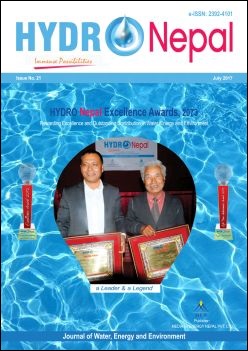Optimizing Location of Cutoffs to Improve Safety and Economy of Hydropower Projects
DOI:
https://doi.org/10.3126/hn.v21i0.17820Keywords:
Hydropower, Water resources, Cutoffs, Safety and economyAbstract
Large numbers of perennial rivers flowing through steep gradient has made Nepal an ideal place for hydropower development. Development of hydropower project in most economical way possible is the first prerequisite to get maximum benefit from harnessing water resources. The maximum benefit can be achieved only through optimal design of the project. Each project component must be designed considering the required level of factor of safety, performance standards of each component and economy. On this backdrop, this paper intends to optimize the location of cutoffs in headworks to get maximum benefits from use of it in terms of safety and economy.
Improper placement of cutoff not only reduces the factor of safety against piping but also curtails the project benefits due to excessive seepage flow. Piping (internal erosion of soil particles under structure) is associated with high exit gradient. It threatens the structural stability and ultimately leads to failure of structure while as excessive seepage flow limits the availability of flow for power generation and reduces the project benefits. So, the optimal design of headworks is an attempt to identify the best location of cutoff to control seepage flow and reduce exit gradient. Five different cases representing different location of cutoff were analyzed and their roles in controlling seepage flow and reducing exit gradient was evaluated to optimize the cutoff location. 2D Finite Element Method (FEM) was used for the seepage analysis. The analysis showed that cutoffs are essential to control seepage flow when dam/weir is founded in pervious soil. However, the best location to place cutoff must be adroitly identified to reap maximum benefit from use of cutoff. The analysis reveals that the role of central cutoff in controlling seepage flow and reducing exit gradient is very limited. Likewise, the u/s cutoff has minimum effect in reducing exit gradient but the d/s cutoff seemed very effective in reducing exit gradient resulting increased factor of safety against piping. Hence, this paper concludes that the d/s end is the optimal location to place cutoff to improve safety and economy of the project. In addition, the use of both u/s and d/s cutoffs extend positive roles both in controlling seepage flow and reducing exit gradient. However, in author’s opinion the construction cost of two cutoffs must be compared with benefit added by use of two cutoffs over use of single d/s cutoff.
HYDRO Nepal Journal
Journal of Water Energy and Environment
Issue: 21, July, 2017
Page: 42-44
Upload Date: July 18, 2017
Downloads
Downloads
Published
How to Cite
Issue
Section
License
The copyright of the articles and papers published is held by HYDRO Nepal Journal.
The views and interpretation in this journal are those of author(s), and HYDRO Nepal does not bear any responsibility for the views expressed by authors in the journal.




